Afghan_Kush_3
SRR 3294451
General Information
- Accession Date
- February 7, 2016
- Reported Plant Sex
- Male
- Report Type
- Whole-Genome Sequencing
The strain rarity visualization shows how distant the strain is from the other cultivars in the Kannapedia database. The y-axis represents genetic distance, getting farther as you go up. The width of the visualization at any position along the y-axis shows how many strains there are in the database at that genetic distance. So, a common strain will have a more bottom-heavy shape, while uncommon and rare cultivars will have a visualization that is generally shifted towards the top.
Chemical Information
Cannabinoid and terpenoid information provided by the grower.
Cannabinoids
No information provided.
Terpenoids
No information provided.
Genetic Information
- Plant Type
- Type II
File Downloads
The bell curve in the heterozygosity visualization shows the distribution of heterozygosity levels for cannabis cultivars in the Kannapedia database. The green line shows where this particular strain fits within the distribution. Heterozygosity is associated with heterosis (aka hybrid vigor) but also leads to the production of more variable offspring. When plants have two genetically different parents, heterozygosity levels will be higher than if it has been inbred or backcrossed repeatedly.
The ratio of reads mapped to Y-contigs to reads mapped to the whole Cannabis genome (Y-ratios) has been demonstrated to be strongly correlated with plant sex typing. This plot shows the distribution of Y-ratios for all samples in our database which were sequenced with the same method (panel or WGS) as this sample and where this sample falls in the distribution.
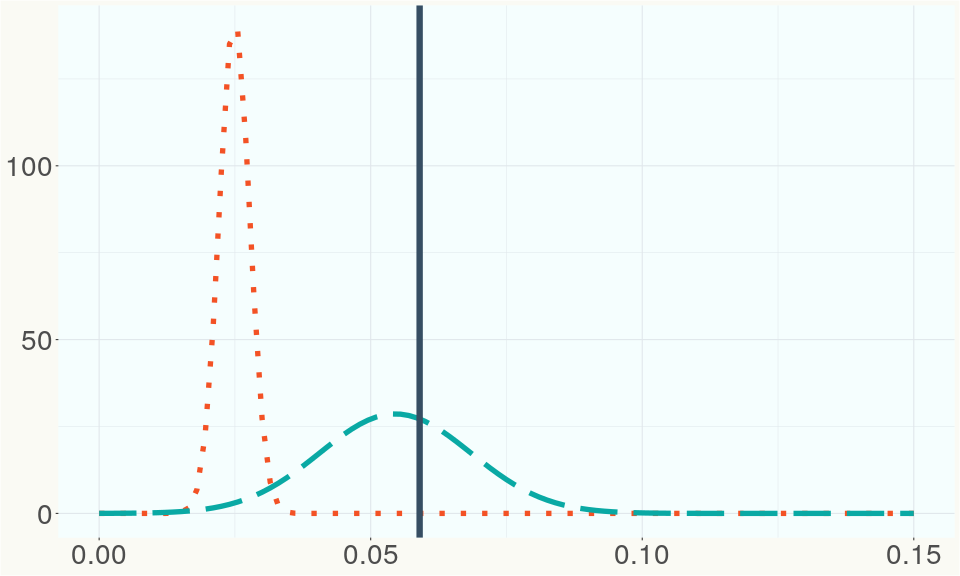
This chart represents the Illumina sequence coverage over the Bt/Bd allele. These are the three regions in the cannabis genome that impact THCA, CBDA, CBGA production. Coverage over the Active CBDAS gene is highly correlated with Type II and Type III plants as described by Etienne de Meijer. Coverage over the THCA gene is highly correlated with Type I and Type II plants but is anti-correlated with Type III plants. Type I plants require coverage over the inactive CBDA loci and no coverage over the Active CBDA gene. Lack of coverage over the Active CBDA and Active THCA allele are presumed to be Type IV plants (CBGA dominant). While deletions of entire THCAS and CBDAS genes are the most common Bt:Bd alleles observed, it is possible to have plants with these genes where functional expression of the enzyme is disrupted by deactivating point mutations (Kojoma et al. 2006).
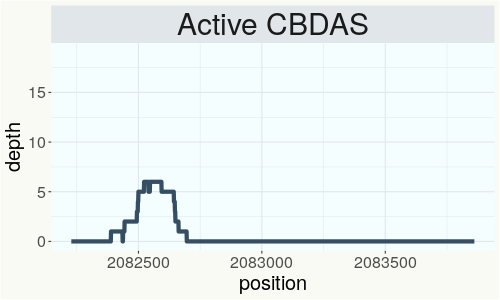
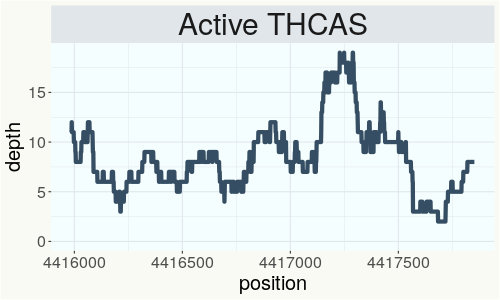
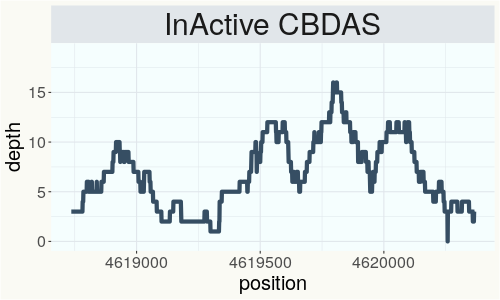
This chart represents the Illumina sequence coverage over the CBCA synthase gene.
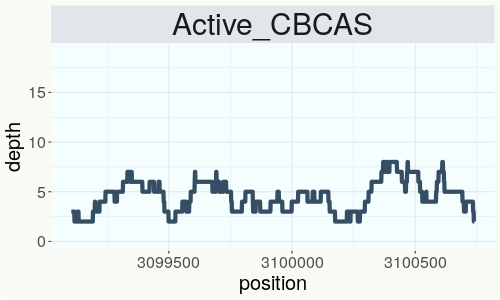
Variants (THCAS, CBDAS, and CBCAS)
No variants to report
Variants (Select Genes of Interest)
| GPPs1 | c.916delG | p.Val306fs | frameshift variant | high | contig676 | 169802 | TG/T |
|
| PHL-2 | c.2756A>C | p.Glu919Ala | missense variant | moderate | contig2621 | 342799 | A/C | |
| ELF3 |
c.1230-2_123 |
splice acceptor variant & intron variant | high | contig97 | 243676 | TAG/T | ||
| ELF3 | c.2141C>G | p.Pro714Arg | missense variant | moderate | contig97 | 244972 | C/G | |
| aPT4 | c.16G>A | p.Val6Ile | missense variant | moderate | contig121 | 2828672 | G/A |
|
| aPT4 | c.97T>C | p.Tyr33His | missense variant | moderate | contig121 | 2828753 | T/C |
|
| aPT4 | c.153A>C | p.Lys51Asn | missense variant | moderate | contig121 | 2828809 | A/C |
|
| aPT4 | c.202T>A | p.Leu68Ile | missense variant | moderate | contig121 | 2828858 | T/A |
|
| aPT4 |
c.235_236del |
p.Val79fs | frameshift variant | high | contig121 | 2829030 | ATG/A |
|
| aPT4 | c.238delT | p.Ser80fs | frameshift variant | high | contig121 | 2829034 | AT/A |
|
| aPT4 | c.302A>G | p.Asn101Ser | missense variant | moderate | contig121 | 2829099 | A/G |
|
| aPT1 | c.406A>G | p.Ile136Val | missense variant | moderate | contig121 | 2839605 | A/G | |
| aPT1 | c.629C>T | p.Thr210Ile | missense variant | moderate | contig121 | 2840237 | C/T | |
| HDS-1 | c.1618A>G | p.Ile540Val | missense variant | moderate | contig1891 | 885936 | T/C | |
| HDS-1 | c.136G>A | p.Val46Ile | missense variant | moderate | contig1891 | 889256 | C/T | |
| HDS-1 | c.56C>G | p.Ala19Gly | missense variant | moderate | contig1891 | 889336 | G/C | |
| HDS-1 | c.35G>A | p.Cys12Tyr | missense variant | moderate | contig1891 | 889357 | C/T |
Nearest genetic relatives (All Samples)
- 0.033 Triangle Kush x Square Wave BX (RSP12100)
- 0.044 UC 70 (SRR14419679)
- 0.050 UC 62 (SRR14419687)
- 0.052 UC 167 (SRR14419585)
- 0.052 UC 46 (SRR14419703)
- 0.054 UC 74 (SRR14419674)
- 0.056 UC 141 (SRR14419609)
- 0.056 UC 493 (SRR14419740)
- 0.057 (SRR3294430)
- 0.071 UC 170 (SRR14419582)
- 0.076 UC 32 (SRR14419761)
- 0.078 UC 500 (SRR14419736)
- 0.078 UC 34 (SRR14419739)
- 0.081 UC 27 (SRR14419817)
- 0.083 VIR 483 (SRR14708238)
- 0.086 UC 89 (SRR14419661)
- 0.086 UC 86 (SRR14419663)
- 0.086 UC 445 (SRR14419766)
- 0.088 UC 18 (SRR14419894)
- 0.091 UC 155 (SRR14419597)
Most genetically distant strains (All Samples)
- 0.413 80E (RSP11213)
- 0.387 Fedora 17 (RSP10661)
- 0.384 Tanao Sri 46 (RSP11486)
- 0.382 Monoica (RSP10241)
- 0.379 JL 4th Gen 1 (RSP11193)
- 0.377 JL 3rd Gen Father (RSP11196)
- 0.368 Cherry Blossom (RSP11306)
- 0.366 Feral (RSP11205)
- 0.365 Cherry Blossom (RSP11317)
- 0.362 80E (RSP11211)
- 0.358 Carmaleonte (RSP11207)
- 0.357 Carmagnola (RSP11037)
- 0.352 Tiger Tail 30 (RSP11484)
- 0.352 USO 31 (RSP10983)
- 0.349 Carmagnola (RSP10977)
- 0.348 JL yellow (RSP11075)
- 0.345 JL 3rd Gen Mother (RSP11214)
- 0.344 Santhica27 (RSP11047)
- 0.343 80E (RSP11212)
- 0.343 JL 4th Gen 6 (RSP11200)
Nearest genetic relative in Phylos dataset
- Overlapping SNPs:
- 3
- Concordance:
- 3
Nearest genetic relative in Lynch dataset
- Overlapping SNPs:
- 3
- Concordance:
- 3
Blockchain Registration Information
- SHASUM Hash
-
a27d2fb1cfa0aa38c49ab17c93ff760e 180c361f111f2731 0b8a146ce513a8f0